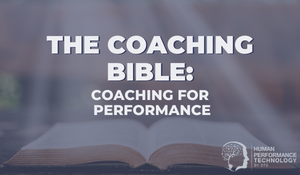In a Nutshell: GROW Coaching Model
The GROW model is the most influential model used in coaching. It was popularised by Sir John Whitmore in his 1992 book, “Coaching for Performance,” which became the bestselling bible of the coaching industry.
The exact origins of GROW are not precisely clear, although it is believed to have been co-developed by several people including Graham Alexander, Alan Fine, Timothy Gallwey and John Whitmore, which have resulted in a number of variations in the public domain, each with slightly different wording and explanations.
The origins of GROW can be traced back much earlier than Whitemore’s book and are intertwined with the very origins of the business coaching movement begun by Timothy Gallwey (author of “The Inner Game of Tennis”) in the 1980s. Gallwey, while working as a tennis coach, noticed that he would often see what a tennis student was doing wrong in their technique but simply telling them what they should be doing did not bring about lasting change. He found instead that coaching, both in sports as well as in business, works best when it is non-judgemental and focuses on the knowledge within the learner, rather than assuming that the coach always knows best.
Coaching is based on the ancient Socratic principle that you can never really teach a person something — they must learn it for themselves. It moves away from a traditional telling/teaching method, and aims to gradually bolster an individual’s awareness, willingness to take responsibility, and become increasingly self-reliant. This is said to foster long-term learning and performance.
The coach’s main role is to draw out a person’s own solutions through questioning. This is where GROW comes in: as a process for working through key questions in more detail.
Overview:
GROW is a simple 4-step questioning model for problem solving in business or in everyday life. The questions can be asked of oneself (e.g., inside one’s head), or out-loud by another person, such as when an employee comes to a manger with a problem.
As there are a number of different versions of GROW, we have followed the structure laid out in “Coaching for Performance” by John Whitmore. These are described at length by Whitmore in his book, however, the very basics of GROW are as follows:
- G – Goals: What do you want?
- R – Reality: What is happening now?
- O – Options: What could you do?
- W – Will: What will you do?
Example GOAL Questions
- What is the desired outcome or result?
- What does the end-result look like in detail?
- Is it one goal or do you actually have several?
Example REALITY Questions
- What is the present situation in more detail?
- What and how great is your concern about it?
- What stopped you from doing more?
Example OPTIONS Questions
- What are all the different ways in which you could approach this issue?
- What would you do if you had more time, a larger budget or if you were the boss?
- What are the advantages and disadvantages of each of these in turn?
Example WILL Questions
- Which option or options do you choose?
- What are your criteria and measurements for success?
- When precisely are you going to start and finish each action step?
In summary, once you are aware of what you want (Goal) and what you current situation looks like (Reality), you are ready to explore the alternative routes and strategies (Options) that can get you to your goal. The final set of questions to be answered involves action: once a path has been chosen, who and what is going to be involved and when will it be done (Will)?
It is also important to point out that Whitemore cautions against using the model in a bureaucratic way — to avoid using it as a strict formula. He notes: “People get stuck on it and they feel they have to go with that sequence… it’s wrong to see it as some kind of Holy Grail.” The GROW model is simply a tool that, at the end of the day, is about helping an individual develop their potential and should be used as an aid (not an impediment) to support a free-flowing exchange of dialogue, which is in line with the overall aim of the coaching philosophy.
Sources
- Coaching for Performance (1992), John Whitmore
- The Inner Game of Tennis (1974), Timothy Gallwey
- A Brief History of The Inner Game, An account by Tim Gallwey (Theinnergame.com)
- The GROW Model: A Simple Process for Coaching and Mentoring (Mindtools.com)
- The GROW Model (Performanceconsultants.com)
- The Tao of Coaching (1997), Max Landsberg
- Interview: Sir John Whitmore shares his thoughts on coaching and the ‘grow model’, 2013, (Edp24.co.uk)
- Coaching Models: A Cultural Perspective: A Guide to Model Development: for Practitioners and Students of Coaching (2010), Diane Lennard
- A Very Short, Fairly Interesting and Reasonably Cheap Book About Coaching (2012), Robert Garvey and Bob Garve
This article offers an expanded description of the summary listed in our post 40 Must-Know HR, OD, L&D Models.

Theo Winter
Client Services Manager, Writer & Researcher. Theo is one of the youngest professionals in the world to earn an accreditation in TTI Success Insight's suite of psychometric assessments. For more than a decade, he worked with hundreds of HR, L&D and OD professionals and consultants to improve engagement, performance and emotional intelligence of leaders and their teams. He authored the book "40 Must-Know Business Models for People Leaders."



We Would Like to Hear From You (0 Comments)